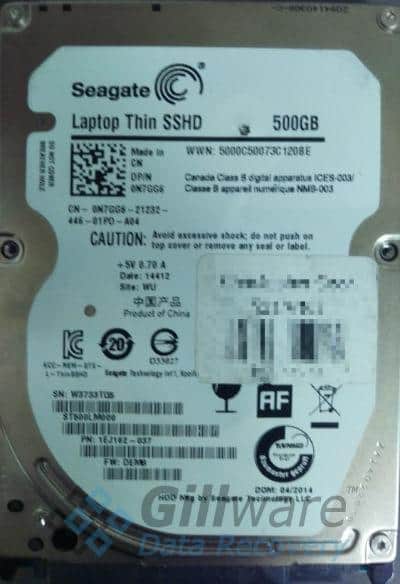Inaccessible Seagate Laptop Thin SSHD
Gillware’s SSHD Repair Services
Seagate introduced its SSHD (Solid-State Hybrid Drive) line of hard disk drives to marry high-speed flash memory with high-capacity hard disk data storage. While the cost per-gigabyte of solid state drives continues to fall, the cost per-gigabyte of hard disk drives still beats it. A one-terabyte hard disk drive is well within the budget of an average consumer. On the other hand, a one-terabyte SSD still is a luxury item.
To provide customers on a budget with at least some of solid state memory’s impressive speed, Seagate developed its own line of hybrid hard drives. Several manufacturers have come up with their own ways to hybridize the two storage technologies. Seagate’s approach puts a NAND flash memory chip on the control board of a hard drive.
The NAND chip doesn’t act like an entire SSD on its own, though. Like in many hybrid systems, it behaves as a cache. The hard drive copies frequently-used data, such as boot files, certain program files, and important user-created files to the chip. When the user boots up their computer or accesses a program in the drive’s SSD cache, the hybrid drive draws on the NAND chip to load these files quickly. Seagate’s hybrid SSHDs offer increased speed over their purely-traditional hard drives, although they can’t quite compete with purebred SSDs.
The NAND chip adds yet another possible failure point to the SSHD on top of the existing failure points of a traditional drive, although the chip is somewhat less likely to fail than the drive’s other components. If the chip becomes corrupt, it can cause the entire drive to fail to boot. However NAND failure is somewhat unlikely. It’s more common for SSHDs to malfunction just like any other hard drive would.
Can’t access your SSHD?

Hybrid Hard Drive Recovery
Our data recovery engineers found that the problem with this drive lay in its read/write heads, with some damage to the drive’s platters. The read/write heads, as their name implies, read and write data to and from the drive’s spinning disk platters. And there is a lot of data to read and write! These heads have to do their jobs very quickly, and when they start to show signs of aging, they can start to lag behind.
This can lead to the hard drive’s equivalent of a kernel panic, and can cause firmware corruption as the heads enter the early stages of failure. Hard drive firmware, the “operating system” of the hard drive, manages all of its functions. But the read/write heads are responsible for talking to the firmware—and what happens when they start misbehaving?
When a consumer suffers hard drive firmware failure, it takes a professional data recovery specialist in a world-class lab to fix it. This firmware can only be accessed using special tools, and only a handful of people in the world actually know how to work with it and properly fix it. A few of those people happen to work at Gillware.
After our engineers fixed the firmware, we began reading data from the client’s Seagate Laptop SSHD. The SSHD repair work went only as quickly as the read/write heads could go. But despite that, with the help of our fault-tolerant recovery tools, it looked like our engineers wouldn’t need to replace the heads altogether. But then the heads in the client’s hybrid hard drive breathed their last, with our data recovery efforts only half complete. We needed a new set to finish the job.
Seagate Laptop Thin SSHD 500gb Failure:
The client in this Seagate Laptop SSHD recovery case came to us with a hybrid SSHD failure. The drive still spun up without making any unusual noises, but the client couldn’t boot their laptop from it or access any of their data. Something was clearly wrong with the drive, and Gillware’s SSHD repair experts were on the case.

Seagate Laptop SSHD Recovery Results
Seagate Laptop SSHD Recovery Case Study: Hard Drive Inaccessible
Drive Model: Seagate Laptop Thin SSHD ST500LM000
Drive Capacity: 500 GB
Operating/File System: Windows NTFS
Data Loss Situation: Hard drive spinning, but unresponsive. Hard drive inaccessible
Type of Data Recovered: Business records and other financial documents
Binary Read: 10.2%
Gillware Data Recovery Case Rating: 9
Our cleanroom technician Drew replaced the drive’s read/write heads with a fresh donor set. Even after the headstack replacement, the going was slow. This is because of an issue with the head adaptives. Each hard drive is unique, and doesn’t take kindly to having new parts shoved into it. It conflicts with the individual calibrations of the drive. Even seemingly-compatible donor parts can quickly fail to work in a hard drive due to the slight differences in manufacturing tolerances, occasionally making hard drive data recovery something of a race against time.
It was a struggle even with the new read/write heads, but our engineers managed to persevere. We successfully read 94.8% of the drive’s file definitions and recovered 92.2% of the known user-created files. After showing the client a list of the recovered files, they confirmed that we had recovered all of their most important documents. We rated this Seagate Laptop SSHD recovery case a 9 on our ten-point scale and sent the client’s data on its way.
Data Recovery Software to recover
lost or deleted data on Windows
If you’ve lost or deleted any crucial files or folders from your PC, hard disk drive, or USB drive and need to recover it instantly, try our recommended data recovery tool.
Retrieve deleted or lost documents, videos, email files, photos, and more
Restore data from PCs, laptops, HDDs, SSDs, USB drives, etc.
Recover data lost due to deletion, formatting, or corruption

